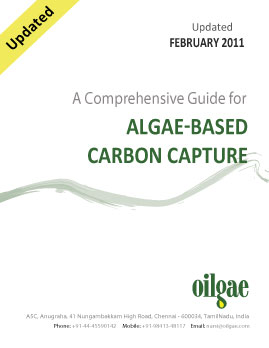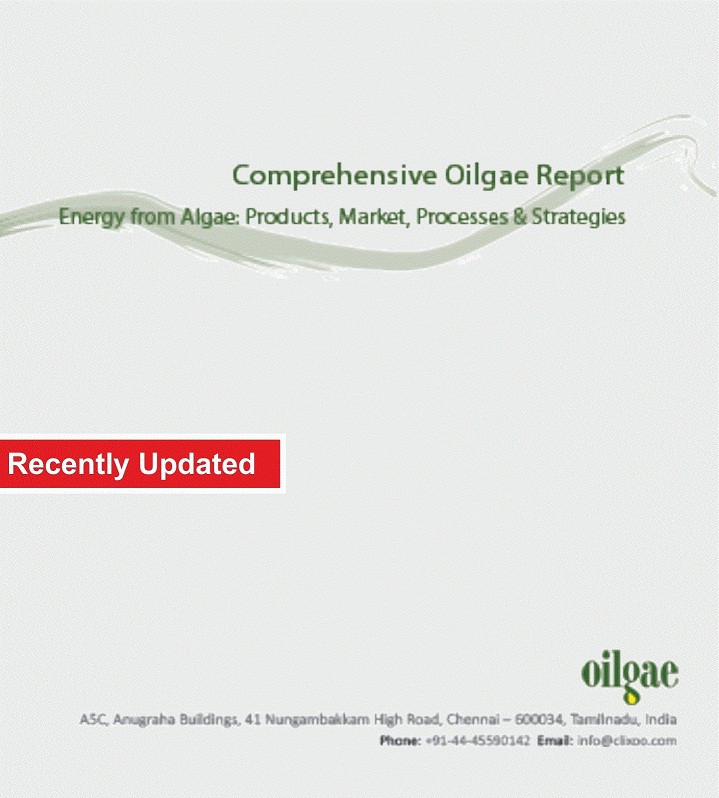
Algae Fuels Digest for Investors
The Most Concise and Precise Guide to the Algae Fuel Industry
Comprehensive Knowledge and Understanding on the following
- A basic understanding of the technologies and processes
- Critical information on leading companies
- Costs of algae fuel production and factors that affect costs
- Key trends in algae fuel research and what the future holds for algae fuels

The Oilgae Digest was developed to provide background and insights on the key parameters driving the algae fuel business - technical and economic feasibility, real industry status, investments and costs, and business success factors. This report is a customized edition for those who wish to get a first level understanding of the critical drivers of the algae fuels industry.
Algae, a third-generation biofuel feedstock, present one of the most exciting possibilities as a future solution to our energy problems, especially that of transportation fuel. In the last few years, activity in this field has been accelerating fast.
Why should you know about algae fuels NOW?
- You will be exploring an alternative to one of our most critical commodities - oil
- You will be learning about a feedstock that has the potential to revolutionize the world of energy
- You will have an early mover advantage as the industry is just about to take off
Why are algae so exciting from a renewable energy standpoint? For a number of reasons:
- The yields of oil and fuels from algae are much higher (10-25 times) than competing energy crops
- Algae can grow in diverse regions, thus ensuring that there is no competition with food crops.
- Algae are excellent bioremediation agents - they have the potential to absorb massive amounts of CO2 and can play an important role in sewage and industrial wastewater treatment.
- Algae are the only feedstock that have the potential to completely replace world's demand of transportation fuels.
- Algae are already being used in a wide variety of industries and applications, and many newer applications are being discovered. Such a wide range of end-uses enable companies to produce both fuels and non-fuel products from the same algae feedstock.
Who should buy this report?
- Investors in Biofuels Industry
- Corporate Chief Executives and Senior Management
- Entrepreneurs both Small and Large
- Management and Strategy Consultants
- Industry and Market Research Companies
- Venture Capital & Private Equity Companies Banks
- Government Departments that Provide Renewable Energy Grants
The algae energy field is still in its nascency. While people around the world have heard about the energy possibilities from algae and would like to know more, few resources are available that provide an overview of the algae energy industry, its potential, the status of various companies in this industry, and what the future is likely to hold for this industry.
Based on our interactions with hundreds of entrepreneurs, investors and businesses who have been exploring this domain in the last few years, we realized the need for a resource that provides structured data, insights and opinion that answers the key questions in their minds.
The following are the key questions potential entrepreneurs have:
- Should I explore algae as a biofuel feedstock?
- Do I have the the skills and resources required for an entrepreneur or business to benefit from this opportunity?
- Do I know enough about the main risks and bottlenecks present in this domain?
- Do I know enough about the future trends to evaluate this opportunity against other energy-related opportunities?
- What can I learn from the performance of existing companies in the algae fuels domain?
The Oilgae Digest was prepared to answer these questions. The Digest is a companion report to the Comprehensive Algae Fuels Report ( http://www.oilgae.com/ref/report/report.html ), which is intended for users more advanced in this field.
An insightful report, Oilgae Digest provides precise inputs for the following questions:
- What is the current and future potential for deriving energy from algae?
- What are the various energy product possibilities from algae?
- What is the real-world status of algae-energy efforts?
- Which are the prominent companies in this field and what are the efforts currently undertaken by them?
- What types of industries and companies will benefit most by investing in this field?
- What is the quantum of investment required in this field?
- What are the key success factors required to succeed in this exciting business opportunity?
- What types of venture capital investments are happening in this industry?
- What are the real bottlenecks / problems that could hamper the growth of this industry?
- What are predictions for the future with regard to challenges, possibilities and breakthroughs?
- What are the next steps you should take should you be interested in exploring further?
Why Should You Buy the Oilgae Digest?
- It answers the most important questions that entrerpeneurs, investors and businesses have regarding algae fuels
- It provides authoritative and critical inputs on one of the most exciting renewable energy sources, in an easy-to-understand language
- It can assist you to quickly take the next steps in this opportunity
- It informs you of the precise status of algae fuel efforts
- It provides insights from industry professionals worldwide
- It has been developed by Oilgae, the definitive and most referenced resource for the algae energy industry.
Balanced Opinion
The goal of the Oilgae Digest is to present an objective status report on the algae fuels industry. Written by professionals who have been observing the industry since its inception and interact continuously with all the key industry players, the Oilgae Digest will assist you to clearly distinguish hype from reality.
View all our reports
| 1. Introduction to Algae Energy 1.1 Algae & Energy - Background & Concepts 1.2 Energy Products from Algae Biomass 1.2.2 Biodiesel 1.3 Algae to Energy Processes1.2.2 Ethanol 1.2.3 Methane 1.2.4 Hydrogen 1.2.5 Other Hydrocarbons 1.2.6 Prominent Companies & their End Products 1.3.1 Strain Selection 1.3.2 Algaculture 1.3.3 Harvesting 1.3.4 Oil Extraction 1.3.5 Conversion of Oil to Biodiesel |
|
|
2. Size & Scope of the Algae Business Opportunity 2.1 Energy Industry Payoffs 2.1.1 Global Energy Industry 2.2 Applications & Uses for Algae2.1.2 Oil - Big Challenges & Big Payoffs 2.2.1 Fuel Applications of Algae
2.2.1.1 Biodiesel
2.2.1.2 Ethanol 2.2.1.3 Hydrogen 2.2.1.4 Methane 2.2.1.5 Hydrocarbons 2.2.2 Non-fuel Applications
2.2.2.1 Bioremediation - algae-based CO2 sequestration and waste-water treatment
2.2.2.2 Other Non-fuel Applications
2.3 Industries that can Derive Synergistic Benefits from the Algae Energy Opportunity
|
|
|
3. Real World Status of Algae Energy Projects 3.1 Prominent Companies 3.2 Status of Algae Fuel in Real World 3.2.1 Industry Concentration 3.2.2. Dominant Designs 3.2.3 Implementation Status of Prominent Companies
3.3.1 Key Challenges Faced by the Algae Fuels Industry
|
|
|
4. Investments & Returns 4.1 Investments 4.1.1 Lab Stage 4.2 Returns4.1.2 Pilot Stage 4.1.3 Commercial Stage 4.3 Costs - Representative Working Out of Cost of Biodiesel Production from Algae
|
|
|
6. Funding & Investments 6.1 Quantum of Venture Capital Investments 6.2 Companies that have Received VC Funding 6.3 Government & Other Public Initiatives 6.4 VC Perspectives, Insights & Recommendations |
|
|
7. Business Strategies 7.1 Key Success Factors 7.2 Niche Strategy
7.4 Lab Stage & Pilot Stage - Details on steps and strategies for these critical stages
7.6 Monitoring for Breakthroughs - Key companies and breakthroughs to watch out for 7.7 Things to Avoid 7.8 Deciding the End Product
|
|
|
8. Predictions Predictions on how energy from algae industry will pan out during the next 10 years, until about 2020. For each of the periods discussed, analysis and predictions are made on the following aspects:
|
|
|
9. Interested? Next Steps 9.1 Organizations - List of organizations related to algae fuels for you to get in touch with 9.2 Algae Collection Centers - Algae strains can be sourced from these centers 9.3 Ask Oilgae - Get in touch with the Oilgae team for additional support |
|
Key take-aways from the report:
- Algae, because of their high growth rate and yields, could produce a lot more oil than other energy crops. Some estimates suggest that microalgae are capable of producing up to 50,000 litres of oil per hectare a year. This could be converted into biodiesel by conventional processes and be used to fuel vehicles from jets to tractors.
- While microalgae strains that are rich in oil content can be used for producing biodiesel, other strains of microalgae and macroalgae can also be used as energy feedstock. Fuels such as ethanol, methane, hydrogen and other hydrocarbon fuels can be derived from these, through a variety of processes.
- It is estimated that there are over 30,000 different strains of algae. While such a large number might indicate exceptional potential for energy production from algae, in reality, only a small percentage of these could be used to derive energy in an economically sustainable manner. There are a number of reasons for this. What such a fact indicates, however, is that it is critical that the most suitable strain is chosen for a specific type of culture medium and for a desired type of energy end-product.
- A drawback of the common open algae culture systems is the major risk of infection by undesirable photosynthetic micro-organisms which can be introduced via air or rain. Such infections can be prevented only by choosing a culture medium which is unfavourable for infectious and other undesirable micro-organisms and favourable to the growth of the desired alga species, so that the latter can win the competition. In a limited number of cases this is possible.
- An alternative to these problems could be to carry out algae cultivation in closed photobioreactors. In these, the process conditions can be accurately controlled, and no infection carrying alga species will occur. A major drawback of the closed photobioreactors is the high investment costs which lead to high production costs.
- Unlike for many other energy crops, the cost of harvesting algae could present a significant challenge to economic energy production from algae.
- The medium in which alga grows is different – the other oilseeds are land crops while algae grow in water
- Microalgae’s physical characteristics are significantly different from those of the primary oilseeds, the main difference being the size.
- Algae are harvested almost everyday, for most part or all through the year, whereas harvesting for most oilseeds is quite seasonal in nature
- Algae have been long used for a number of non fuel applications and products. These include its use in animal feed, nutraceuticals, cosmetics and more.
- Algae also present an interesting opportunity as a bioremediation agent – algae can be used to sequester CO2 from power plants, and they can be used to remove nutrients from waste water and sewage.
- The algae energy industry is just about 4-5 years old, but there are a few companies that have already achieved prominence. The following is the list of companies that have been able to make good progress so far
- Aquaflow Bionomic
- Cellana
- OriginOil
- PetroAlgae
- PetroSun
- Sapphire Energy
- Seambiotic
- Solazyme
- Valcent
- The real challenge facing the algae industry is the high cost of fuel production from algae. The other significant challenges include:
- Difficulty in optimal strain selection
- High capital cost of photobioreactors
- High cost of harvesting
- Difficulties in genetic manipulation of algae
- High capital cost of biomass gasification
- Contamination management in open cultivation environments and in waste water/sewage
- High operational and capital cost of algae based CO2 sequestration at power plants and other industries
- Difficulty in getting high quality scientific talent
- Oilgae estimates that algae oil could cost up to $15 per gallon for production
- Typically, companies venturing into the algae fuels industry go through three stages:
- Lab stage,
- Pilot stage, and
- Commercial stage
- Apart from startups, the other group of companies entering / that has entered the algae energy domain comprises established companies who are already operating in the energy/alternative energy/biofuels domain or in domains closely related to algae.
- In July 2009, ExxonMobil announced a $600 million investment in algal fuel research and development. ExxonMobil’s project is noteworthy in light of the collaborative involvement of Synthetic Genomics which is experimenting with algae genetics to develop strains that produce ever-higher quantities of oil, reducing the cost and effort required to extract the refinable materials. In August 2009, BP also joined the algae fuel club with a $10 million investment in Martek Biosciences.
- Scientific Talent is a Key Success Factor - The key success factor for the industry at this stage of its lifecycle is the amount and quality of relevant scientific expertise available with the company. The real challenges facing the industry now (and for the next 3-5 years) are scientific in nature; hence, fundamental and applied research expertises are the most important ingredients a startup should bring with it.
- Exploring Opportunities in Support Industries - If the risk profile of the algae energy does not fit an entrepreneur’s business aspirations, he/she could still be involved in this industry – by investing in industries/sectors that support this industry. Examples of such sectors include photobioreactor design and manufacture, implementation of open and closed raceway ponds, integration of power plant CO2 emissions with an algae cultivation facility, equipments for harvesting & extraction, consulting, research equipments such as microscopes, analytical equipments and more.
The reasons lie in the differences present between harvesting algae and other energy crops:
Algae + Wastewater / Sewage = Clean Water + Biofuels!
|
|










